Move Aside Tuscany! From Konavle to Istria, Vogue Praises Croatia
February the 21st, 2023 - No less than the well respected Vogue magazine has showered praise on Croatia, hinting that it is better than Tuscany and applauding this country's outstanding wine offer, from Konavle to the Istrian peninsula.
As Poslovni Dnevnik writes, the prestigious Vogue magazine recently devoted some of its reportage to gorgeous Istria, where it singled out several must-visit destinations. Each of the destinations chosen is adorned with beautiful nature, as well as numerous gastronomic charms that should be an excuse for you to pay a visit, according to the mag.
In its report under the title ''Tuscany, move aside - why Croatia should be on everyone's radar,'' Vogue magazine listed several reasons as to why the Istrian peninsula could be a better choice as a holiday destination than Tuscany, B92 reports. According to the magazine, the best of all that Istria has to offer is its impressive wine.
When you think of Croatia, wine may not be the first thing that comes to mind. In addition to turquoise beaches and historic cities that have made Croatia a favourite summer destination, its agricultural wealth consists of hectares of centuries-old vineyards and olive groves that span steep slopes and green valleys.
Last year, Croatia achieved a record at the prestigious Decanter World Wine Awards. It won three platinum and sixteen gold medals, which stimulated even greater interest in small-batch wines. Today, with an increasing international focus on its 130 indigenous grape varieties, theecountry is finally gaining recognition as a destination for wine lovers. Along with this boom in winemaking, a new generation of design-advanced hotels and modern infrastructure have made it easier to stay in the four main Croatian wine regions.
Two of them are located on the coast, and entry into the Eurozone and the Schengen zone have also contributed to Croatia's popularity. Vogue singles out Konavle, Istra and Peljesac as top Croatian destinations for wine lovers.
As for Croatia's wealth of stunning natural beauty, Vogue wrote about river waterfalls and hiking trails, idyllic places and family farms (OPGs). Istria was nicknamed the ''new Tuscany'' because of its signature rolling hills dotted with olive groves, vineyards and forests full of truffles.
Due to its location, the Istrian peninsula has always connected the Mediterranean with the continental part of the country. This is exactly how opposite cultures and influences came together in the best way, which is the basis of the diversity and richness of the gastronomic offer of this peninsula.
For more, check out our dedicated news section.
Dubrovnik-Neretva Beaches More Accessible for People With Disabilities
May the 29th, 2022 - Three Dubrovnik-Neretva beaches are now more accessible to people with various forms of physical disabilities thanks to a new move within the wider MIMOSA project.
As Morski writes, three Dubrovnik-Neretva beaches have now finally been properly and safely equipped with lifts for people with disabilities. They were procured as part of the praiseworthy MIMOSA project.
From this summer season onwards, people with disabilities will be able to enter the sea on three more Dubrovnik-Neretva beaches more easily on the beaches in Orebic, Slano and in Molunat, which lies to the south of the city.
Lifters for people with disabilities have been set up in co-operation with local self-government units to facilitate access to the sea for people with disabilities and people with reduced mobility. The total value of the three lifters installed in the municipalities of Orebic, Konavle and in Zupa Dubrovacka stands at 300 thousand kuna.
The MIMOSA project is otherwise being implemented within the Interreg Italy-Croatia cross-border cooperation programme, and its main goal is to improve the quality, safety and environmental sustainability of coastal transport services by promoting multimodality and connecting multiple forms of transport within the programme area, but also raising the general level of awareness of both citizens and tourists when it comes to offering modern and more environmentally friendly solutions.
Italy aside, Dubrovnik-Neretva County has 369,735.00 euros at its disposal for the realisation of various MIMOSA project activities, and the project activities will be realised by the end of 2022.
As part of the project, a website for cycling tourism in Dubrovnik-Neretva County is being developed, and work is underway to arrange a cyclopoint (centre) in Popovici, which lies to the south of Dubrovnik, which will be equipped with equipment for cyclists.
In addition to all of the above, at nineteen different locations within the county, the installation of nineteen bike service sets and twenty new parking racks for bicycles is planned.
For more, make sure to check out our dedicated lifestyle section.
Croatian Traditional Jewellery: Coral, Silver and Gold in Dalmatia
February 26th, 2022 - Following our feature dedicated to traditional jewellery of Istria, a look at the intricate filigree pieces traditionally worn in Dalmatia
In the first part of this series, we wrote about medieval jewellery discovered in Istria that has only recently seen a revival in the form of artisan replicas.
The traditional jewellery of Dalmatia, however, has historically been an integral part of folk costumes all over the region, and has been worn and treasured by generations of women up to the present day.
Let's take a look at some of the most prominent designs found in Dalmatia:
Pag beaded necklace and earrings / Paški peružini i ročini
First, a quick disclaimer: depending on who you ask, Pag island is a part of Kvarner, Dalmatia, neither, or both. We'll leave the people of Pag to define their cultural identity as they see fit, and will include the island in this particular feature based on the shared traits of traditional jewellery of Pag and that found in the rest of Dalmatia.
The traditional costume of Pag island largely owes its distinctive appearance to the triangular headdress worn by women, made of starched white linen and lined with intricate lace.
The Pag lace is a showstopper, but if you take a closer look, you’ll see that the ladies are also adorned in jewellery when clad in traditional garb. It’s been worn on Pag since the 16th century, and considering that there were no master goldsmiths living on the island at the time, the jewellery was imported from Venice.
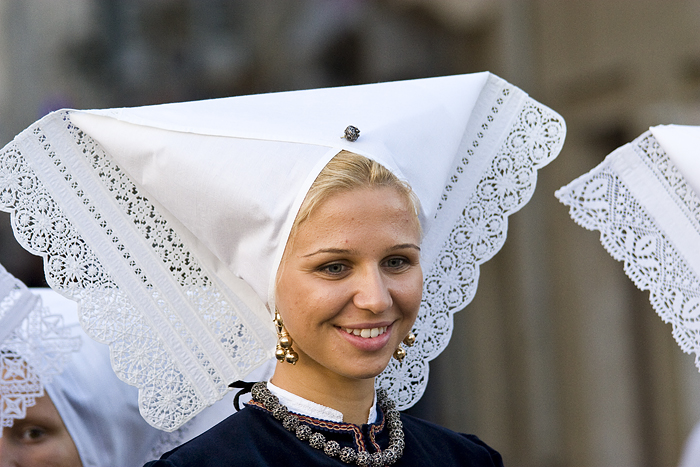 Pag folk costume / Image by Hotel Biser
Pag folk costume / Image by Hotel Biser
There are two distinct types of jewellery worn as part of the Pag folk costume. Delicate beads made in the filigree technique are called peružin; string a number of them together and you get a gorgeous necklace. Decorative hair pins featuring a single peružin were used to help keep the headdress in place, as seen on the above photo. It should be mentioned that the traditional peružini were once made to weigh exactly 123 grams each!
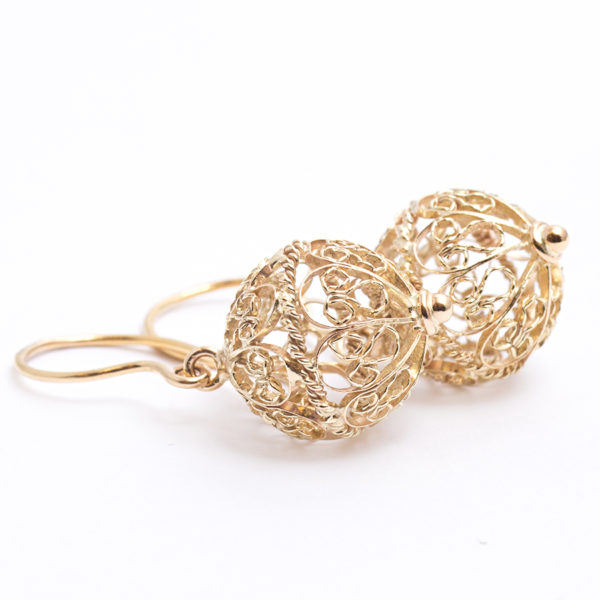 A modern replica of Pag peružini / Image by Zlatarnica Jozef Gjoni
A modern replica of Pag peružini / Image by Zlatarnica Jozef Gjoni
The other distinctive piece found on Pag are the ročini, dangly bell-shaped earrings typically made of silver or gold.
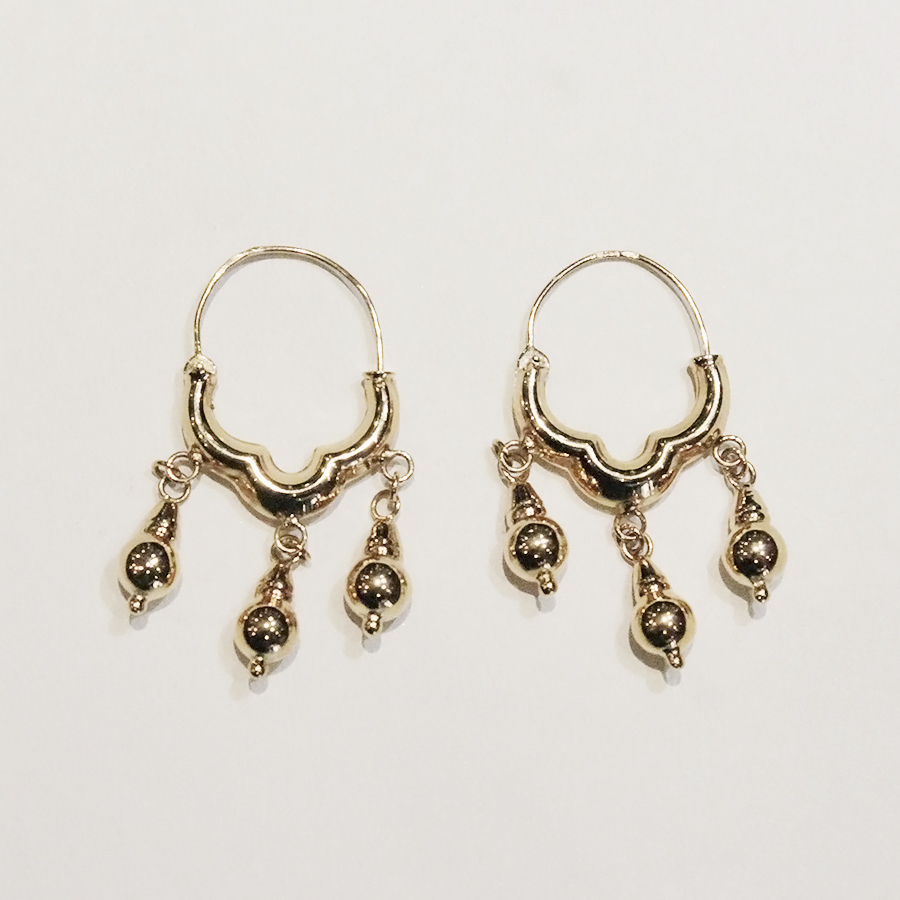 A modern replica of Pag ročini / Image by Zlatarnica Jozef Gjoni
A modern replica of Pag ročini / Image by Zlatarnica Jozef Gjoni
Šibenik button / Šibenski botun
Arguably the most popular piece on this list, the intricate Šibenik button used to be a decorative part of men’s folk costumes. These days, it’s one of the most recognisable symbols of Šibenik that doubles as an authentic souvenir. And while the motif is still seen in men’s accessories - tie clips, cufflinks - it’s not exclusive to gents anymore and is featured in women’s jewellery as well.
Similar to the Pag peružin, the Šibenik button is a hollow filigree bead composed of two half-spheres bonded together. Traditionally, the button used to be made of silver, but nowadays you’ll also find modern replicas made of gold, rose gold and aluminum. It's also called puce and toka, and was known to come in different sizes and designs depending on intended use.
 Various versions of Šibenik buttons
Various versions of Šibenik buttons
Even though there are metal buttons discovered in Dalmatia that date back to ancient times, the famous decorative bead only became widely adopted as a part of traditional garb around the 17th century.
As mentioned, they were only worn by men back then and were an indicator of social status and rank. The buttons were essentially comparable to military medals, as they were awarded to heroes and commanding officers from the region by Venetian generals based in Zadar.
Over time, the Šibenik button became so popular that a large number of artisans, from northern Dalmatia all the way to Albania in the south, specialised in the filigree technique so that they could create the intricate orbs.

Šibenik button earrings / Image by Zlatarnice Rodić Facebook
Zlarin coral / Zlarinski koralji
For a little intermezzo on our filigree-laden tour, we’re heading to Zlarin island right off the coast of Šibenik, historically known for quite a specific thing: coral.
People of Zlarin have dealt in coral harvesting and processing since the 14th century; while harvesting isn’t that common anymore, Zlarin is still home to a handful of skilled artisans creating unique coral jewellery.
 Red coral necklace / Šibenik Tourist Board
Red coral necklace / Šibenik Tourist Board
Red coral, also called precious coral, thrives in clean waters and grows at the depth of 30 to 200 metres. In its natural state, it’s covered in a crust that needs to be filed down for its intense red colour to show; the skeleton is then cut into smaller pieces, each of which gets filed, shaped and polished. Polishing is the most crucial stage, a process that can last up to a few days and results in a high shine. The colour has a range of 10-15 hues, varying from a light to a deep red.
The art of coral harvesting was a skill passed from father to son. Coral was historically harvested by trawling, using a tool called inženj, a wooden cross weighed down with a heavy stone and fitted with fishing nets. Coral would get entangled in the nets as they dragged across the seabed and break off when the nets were pulled out of the sea.
Fishermen from Zlarin participated in harvesting expeditions all over the Adriatic - sometimes straying even further, as far as Greece - and sold the catch on Sicily.
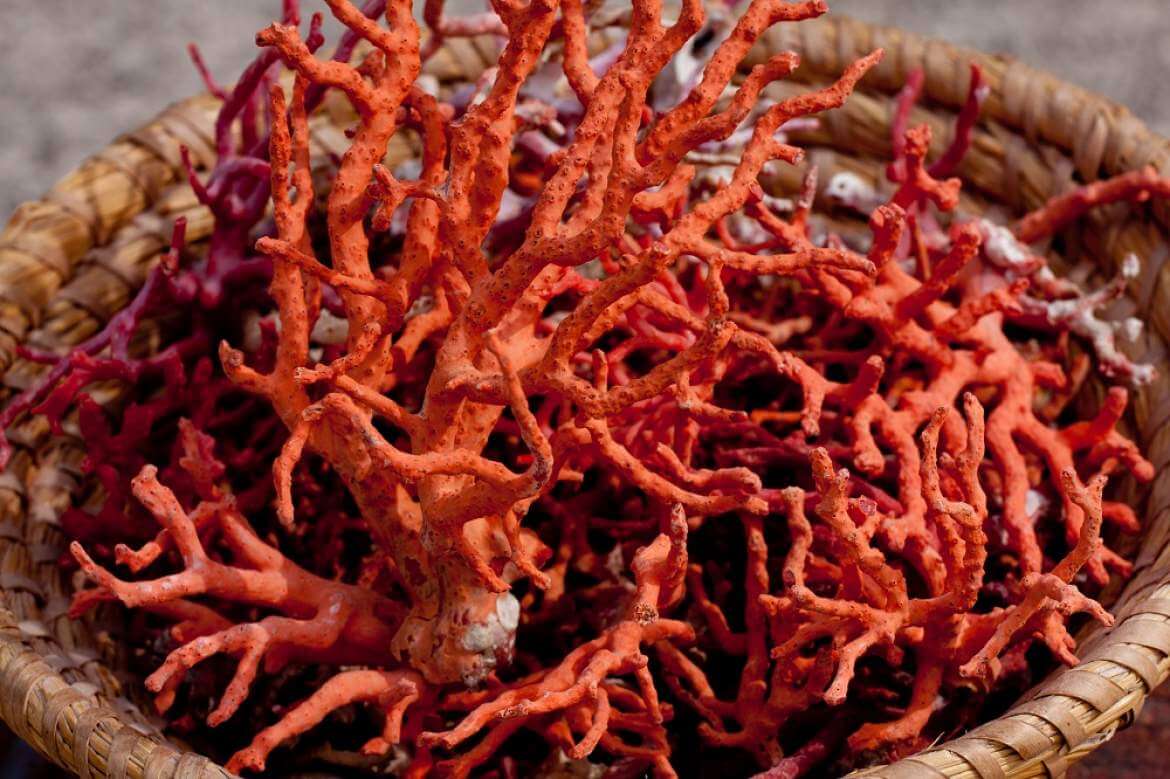 Red coral / Zlarin Tourist Board
Red coral / Zlarin Tourist Board
After the fall of the Venetian Republic that controlled the coral trade in the Adriatic, the people of Zlarin were granted the exclusive right to coral fishery. Like elsewhere in the Mediterranean, coral was overharvested due to its value until it was nearly eradicated, and so the practice gradually became less common by the mid-20th century.
Nowadays, the island is home to two coral shops run by jewellery makers that keep the tradition alive. Zlarin is also about to get a Croatian Coral Centre, a state-of-the-art facility dedicated to the island’s history of coral harvesting that's set to open sometime soon.
Konavle earrings / Konavoske verižice & fjočice
We’re heading further south, to the Konavle area near Dubrovnik, the home of the elegant Konavle earrings.
The verižice hoop earrings from Konavle have a small pendant, typically a pearl or a coral bead. In the olden days, there was a social order to wearing jewellery in Konavle: young girls wore smaller earrings, and the older the women got, the bigger earrings they could wear. Young men were known to present their brides with the lovely hoops as a gift before their wedding day.
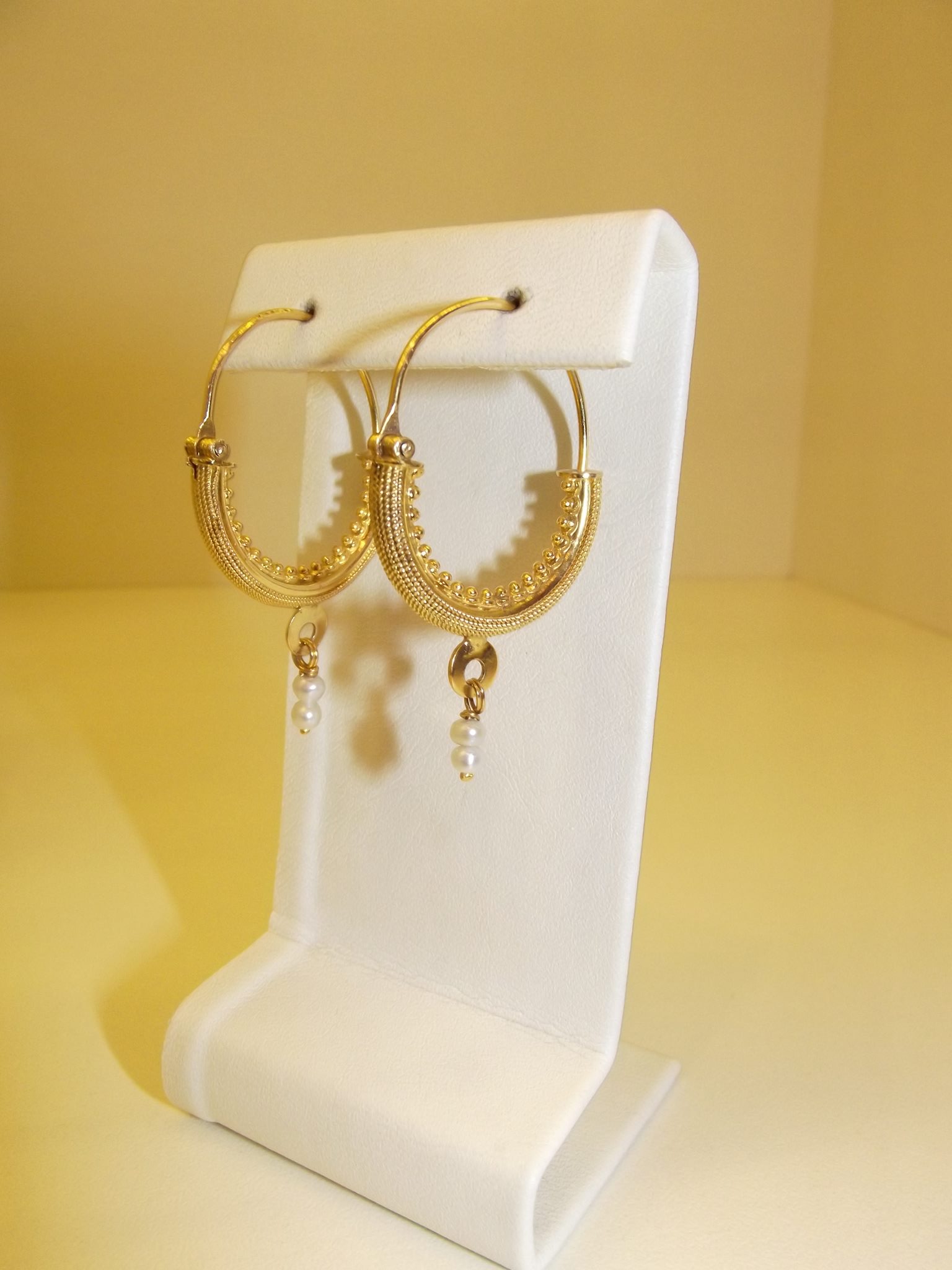 Modern replica of Konavle earrings / Image by Zlatarnice Rodic Facebook
Modern replica of Konavle earrings / Image by Zlatarnice Rodic Facebook
Traditional jewellery was handled with care and kept in decorative wooden boxes or in special compartments in chests. The best pieces were only worn in rare special occasions, as jewellery was considered a family heirloom and was passed down from generation to generation.
Another type of earrings popular in Konavle are the so-called fjočice. Worn by brides on the day of their wedding and in the first year of marriage, the dangly earrings had several pendants made in gold filigree.
The Croatian Post paid homage to the lovely fjočice with their own postage stamp, created by designer Alenka Lalić from Zagreb:

Interestingly, the Konavle earrings weren’t actually made in the Konavle area, but were instead manufactured by goldsmiths in Dubrovnik. In the 19th and 20th centuries, the goldsmith workshops predominantly focused on traditional jewellery, driven by the increasing demand from Konavle and the wider Dubrovnik area.
Dubrovnik necklace / Dubrovačke peružine & kolarin
As Dubrovnik used to be a major goldsmithry centre from the medieval times to the mid-20th century, it doesn’t come as a surprise that the Pearl of the Adriatic has its own type of traditional jewellery.
You’ll surely recognise the peružin motif by now, the hollow filigree beads which in Dubrovnik were traditionally made of gold. Strung together, the beads make a lavish necklace called kolarin.
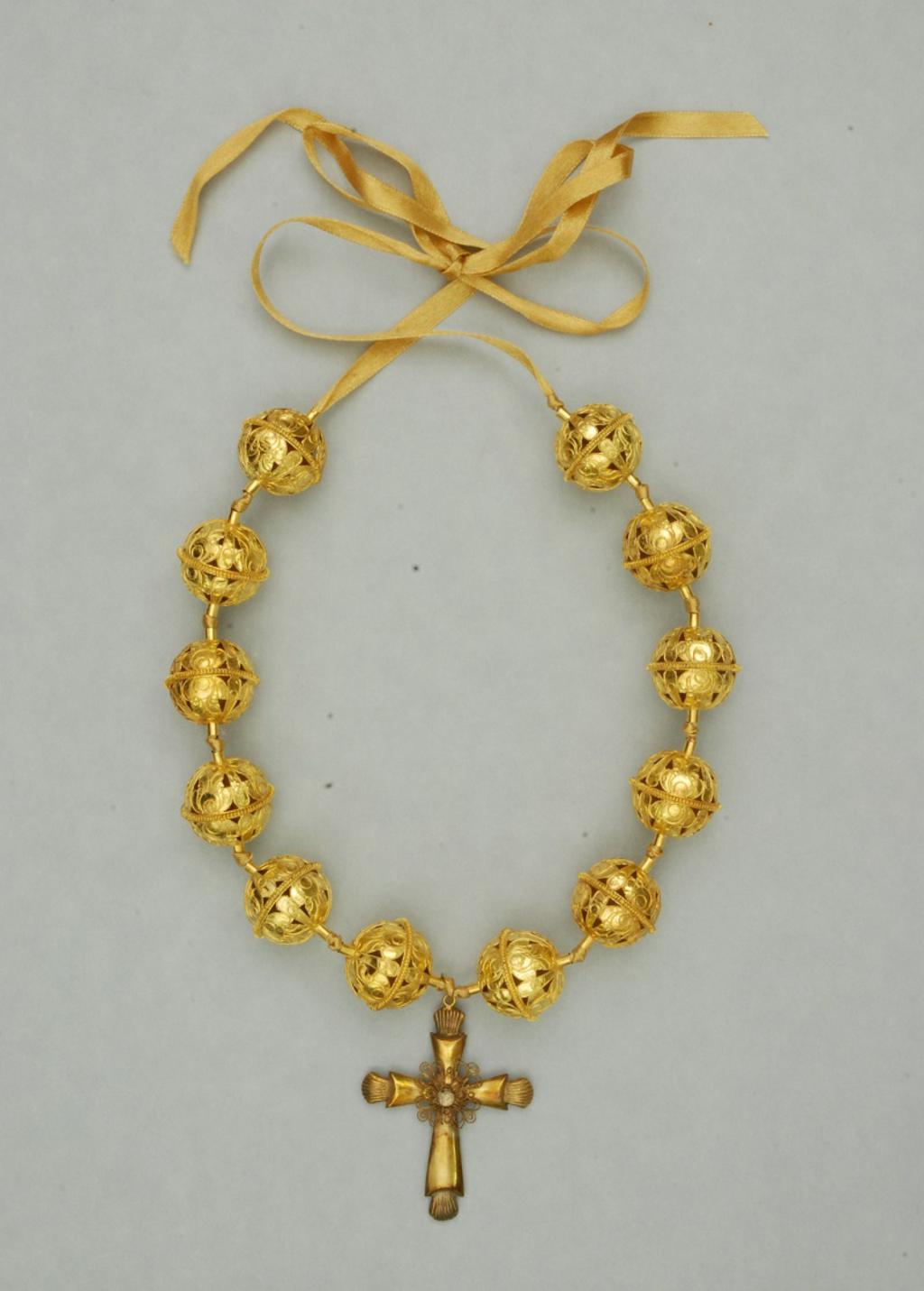
The kolarin were most commonly composed of 12, 14, 16 or 18 peružin beads, either simply strung on a silk ribbon, or connected with small golden links, pearls or coral beads. They were known to feature a heart-shaped pendant or a golden cross, altogether making a show-stopping piece typically worn on special occasions.
Nowadays, you'll most commonly find earrings or pendants featuring the Dubrovnik peružin bead.
Cavtat Among 15 Best European Destinations for Vaccinated Travelers
March 8, 2021 – While the European Union is deciding on introducing COVID passports, some travel portals are already making lists of the best destinations for people who got vaccinated. One such list created by the European Best Destinations portal included Cavtat among the 15 best European destinations for vaccinated travelers.
The Croatian town of Cavtat has recently been nominated for the best European destination and won third place. However, this time, it has found its position on the list of the 15 best European destinations, but for vaccinated travelers. Namely, the European Best Destinations (EBD) has listed Cavtat among the 15 best European destinations for vaccinated travelers, as destination travelers will most likely be able to visit.
As EBD reports, Cavtat is considered one of the safest destinations in Europe due to a low number of COVID-19 cases and proximity to airports (in case of repatriation) and hospitals. Also, the authorities' health measures and a wide range of accommodation options favor Cavtat's title of one of the safest European destinations.
As EBD calls it, this precious key will open the doors to a country renowned for its hospitality, gastronomy, sun, natural wonders, and magnificent beaches. Cavtat is, therefore, perfect to recharge batteries, enjoy good restaurants, meet locals, stroll around, or bathe in the crystal blue waters of the Konavle region.
Cavtat is once again in the chosen company of European destinations, among them: Tbilisi – the capital of Georgia, Portuguese Madeira and the Azores, Greek Rethymno, Kefalonia, Rhodes, Kos, and Athens, Iceland, Spanish Seville and the Canary Islands, Copenhagen and Rubjerg Knude of Denmark, and the Swedish capital Stockholm.
The European Union is currently working on introducing the so-called COVID passport, and some European countries have already recognized it. Numerous European countries have announced that they will make it easier for vaccinated travelers and tourists to enter their country.
However, Croatia has not yet officially responded to the topic of COVID passports. The Croatian media have recently learned that Croatian politics generally supports all efforts that will result in easier border crossings, but only if it will not be discriminatory towards citizens. Therefore, Croatia will support COVID passports only if it would not be mandatory for passengers.
For the latest travel info, bookmark our main travel info article, which is updated daily.
Read the Croatian Travel Update in your language - now available in 24 languages.
Konavle Wedding Toast Named Another Croatian Protected Intangible Good
February 11, 2021 – The Municipality of Konavle has received yet another recognition of ''protected intangible good of Croatia''. After the art of making Konavle embroidery won the title, the Konavle wedding toast has now officially received the same status.
As reported from the Municipality of Konavle, the Konavle wedding toast has officially been given the status of a protected intangible good. Thus, in addition to the art of making Konavle embroidery, which was declared an intangible cultural good back in 2015, the Konavle wedding toast is the second protected intangible good to come from Croatia's southernmost municipality.

Konavle is the southernmost part of Croatia / Photo: Cavtat Konavle Tourist Board
The Konavle wedding toast is a well-known longer speech performed at Konavle weddings which involves drinking to health and well-being. It is performed by a toastmaster before the wedding, before the baked or main meal at the wedding ceremony. The guests stand on their feet with their glasses of wine in their hands and actively participate in the toast.
Until the middle of the 20th century, the toastmaster would be one of the wedding guests or family members. Today, a toastmaster is invited specially for that occasion. Fortunately, in Konavle, this custom still lives on thanks to local toastmasters, who are also the bearers of this good. It is undoubtedly one of the most heartwarming moments at every Konavle wedding.
The Konavle wedding toast congratulates everyone, and especially the bride and groom, and prays to God for their success and happiness in their joint life to come.
Toasting at weddings is also common in other parts of Croatia, but the Konavle toast best reflects the centuries-old faith and culture of the people from the extreme south of Croatia. In Konavle, almost every village has its own kind of toast. However, when it comes to the general message given through it and the way it is expressed, all Konavle toasts are equal.
With the Konavle embroidery, the essential decorative element of women's costumes in this part of the wider Dubrovnik region, which is made on busts and cuffs, Konavle is now richer for another intangible cultural good.

Konavle embroidery / Photo: Dubrovnik Tourist Board
For the latest travel info, bookmark our main travel info article, which is updated daily.
Read the Croatian Travel Update in your language - now available in 24 languages.
Croatian City Cavtat Nominated for the Best European Destination 2021
January 25, 2021 – Croatian city Cavtat is among the 20 nominated destinations to win the title of the best European destination 2021.
The European organization Best European Destinations (EBD) organized the selection for the best European destination this year, and the Croatian city of Cavtat is among the 20 nominated European destinations on the list, reports the National Croatian Tourist Board.
Apart from Cavtat, the southernmost Croatian city, the destinations chosen this year are Vienna, Rome, Kefalonia, Paris, Lofoten, Canary Islands, Gibraltar, Capri, Cornwall, Dordogne river valley, Tahiti, Soča river valley, Tubingen, Cappadocia, Ghent, Kotor, Sibiu, Braga, and Florence.
If you would like Cavtat to win the best European destination title, you can vote online via this link from January 20 to February 10, 2021. Voting can be done once in seven days.
Also, following the situation with the coronavirus in Europe, EBD grants the right to use the logo "European Safest Destinations 2021" to destinations with an extremely low incidence of COVID-19. Given the good epidemiological situation from the beginning of the pandemic, Cavtat received this valuable label, i.e., help and tools to promote the destination.
As a reminder, the European Best Destinations portal is a European organization based in Brussels, and the main organization's activities include the promotion of European culture and tourism. Addressing the audience through online channels, the portal has an essential role in promoting Europe as the number one destination globally. It also offers tourist information for more than 355 European destinations.
Five years ago, the Croatian city of Zadar won the title of the best European destination in this selection, while other Croatian destinations have repeatedly been included on the nominates' list. This is not the first nomination for Cavtat either. Namely, in 2019, Cavtat took eighth place in the same selection. The European Best Destinations portal then described Cavtat as "a real gem" and "one of the most attractive destinations on the Adriatic coast" due to its rich cultural and historical heritage, as well as offered services for tourists, and its gastronomy.
Last year, out of Croatian destinations, the city of Rijeka was nominated for the best European destination, and in the end, it took eighth place on the list. Three years ago, the Croatian island of Hvar took a high fourth place on this same list.
For the latest travel info, bookmark our main travel info article, which is updated daily.
Read the Croatian Travel Update in your language - now available in 24 languages.
VIDEO: Skipjack Tuna Not Seen in Croatia Since 1945 Caught Near Prevlaka
As Morski/Jurica Gaspar writes on the 4th of November, 2020, a passionate fisherman from Grude in Croatia's southernmost county of Konavle recently caught an unusual species of tuna near Prevlaka, close to the Montenegrin border.
''I caught a skipjack tuna! I thought it was an Atlantic bonito before we hooked it. The cleaned one weighs 6.9 kg,'' Denis Markovic told Morski, and the experts were then asked to reveal a little more about this species, which lead to the realisation that this is an unusual discovery indeed in Croatian Adriatic. Namely, this type of tuna in has not been documented in Croatian waters since 1945!
''There was a whole school of them. One fell off,'' Denis Markovic said when detailing his experience, which he recorded on video.
''You can see the fight it put up and her behaviour. It was extremely strong. It was caught with the shore jigging technique. It is rough to the touch, so it surprised me at first,'' he said.
''First I called my friend Ivan Radovac to ask what kind of tuna this is, at first I thought it was an Atlantic bonito, to which he replied that no, it was indeed a tuna. After an interview for Morski, I was contacted by the Institute of Oceanography and Fisheries in Split, they confirmed the species to me, told that it isn't protected and that it's the only one recorded here since the 40s, which is now a museum specimen,'' explained Markovic, who is ready to give the fish he caught near Prevlaka to science.
Pero Ugarkovic is the editor of the Podvodni.hr portal and one of Croatia's greatest experts on underwater flora and fauna, he decided to explain more about this unusual catch down in Prevlaka.
''According to the description, I suspected that it could be skipjack tuna. After seeing photo, there was no doubt, it's the species I've been waiting for a long time to appear in the Croatian Adriatic.
Is this an Adriatic species?
''This species was officially discovered for the first time in the Adriatic by Dr. Soljan back in 1945 close to Trogir. He kept that fish in the Natural History Museum in Zagreb. Together with Dr. Dragicevic from the Institute of Oceanography and Fisheries, I tried to find out if there were any other finds like that in the Adriatic, and apart from that specimen, which is still in the museum, we were unable to obtain any other information.
This means that there is no other documented finding of skipjack tuna to date. It's possible that someone once caught one, but that they kept that information to themselves or among a close circle of people. I've heard of some alleged catches down in Montenegro, but without seeing an avtual specimen, a clear image or video, such a finding can only be considered indicative, or potential, but not official. It should also be noted that it isn't possible to know how many times skipjack tuna have entered the Croatian Adriatic without anyone ever seeing them.
Where does this species otherwise inhabit?
''This species lives all over the world, in tropical and subtropical conditions, it's one of the most important commercial and traditional fish species. Maybe more people in Croatia ate this type of tuna than, say, our own tuna, because if you look at the composition of canned tuna, you'll see that it contains it.
As for the Mediterranean, it appears exclusively in the western part of the sea, seasonally, mostly along the coast of Spain and sometimes on the western side of Italy. I've been following these topics on social media in all Mediterranean countries for a long time and I don't remember seeing this species more than 10 times. Just like in this case, they also appear in the western Mediterranean in the autumn period because the sea temperature is the most suitable for them then,'' Ugarkovic added.
Skipjack tuna are also commonly referred to as the ''tuna for the poor'' and it remains to be seen if any more of them will show up in Prevlaka or indeed anywhere else along the Croatian coast.
For the latest travel info, bookmark our main travel info article, which is updated daily.
Read the Croatian Travel Update in your language - now available in 24 languages
Light At End of Tunnel for Konavle?
August 29, 2020 - I have been travelling and working between the UK and Croatia for the past 4 years or so after falling in love with the county of Konavle during a cycle touring trip a few years back. I was kindly hosted by Marko Bradvica at Mikulići Nature Park, a man with a big dream regarding a small train!
There are a few generations growing up in the area that never remember Čiro ever chugging its way up the side of Sniježnica mountain on its way to Vojski Do or departing the harbour in Dubrovnik on its winding journey toward Mostar. The Čiro route, now a walking trail, offers stunning panoramic vistas of our beautiful coastline and beyond, a would-be attractive hike for tourists if the summer temperatures weren’t quite so high!
When I was first discussing with Marko the rich history of this often forgotten corner of Croatia the train regularly came into the conversation and since I’ve heard many romantic anecdotes from others describing a train line that did much for the people here and hopefully still will! Perhaps most notably a beautiful account from our friend Danielo who describes his first journey on the train during his first visit to then Yugoslavia as a student in the 1950’s have a read here.
The author Stanislav Vukorep wrote a book chronicling Čiro’s rich history titled ‘Pruge koje su zivot znacile’ or ‘The tracks that brought life’. So important was the train for transport and infrastructure back then, it enriched a large part of the Dalmatian coastline for many, an essential attribute to local commerce as we hope will be the case again.

Recently Croatian tourism and the Dubrovnik strip especially, have been devastated by the effects of the Coronavirus. The usual tourist numbers in the area have plummeted; down by significant percentages comparative to a steady few years of exponential growth, hard times for many in the area however here at Čiro HQ we remain ever confident that the train will roll again. Previous to the virus, year upon year tourist numbers were steadily rising, 2019 reporting an increase of 13% over the previous year with a total of 1.3 million tourists visiting Dubrovnik and its surroundings.
So what do all these tourists do? Stari Grad or the Old City of Dubrovnik, the Pearl of the Adriatic is a huge pull to tourists from all over the world. Its imposing walls lauding over the Adriatic Sea beyond yet quaint cobbled streets provide visitors with ample photo opportunities and an insight into its rich historical past, an absolutely fantastic place if you are happy to queue for a few hours just to get inside!
Limited space between those mighty walls restricts the number of tourists at the height of the season, one might only cope with half a day there before the crowds become oppressive and the beach beckons. Beaches are great, I myself am one of their largest fans however even time spent cooking in the sun with dips in the ocean for relief eventually become tedious, what next? ‘’Kovavle...’’, I say, ‘’...a train ride into the mountains’’, ‘’Huh? Konavle, train, what?’’ you quiz, ‘’Čiro!’’ I simply reply with a smile.
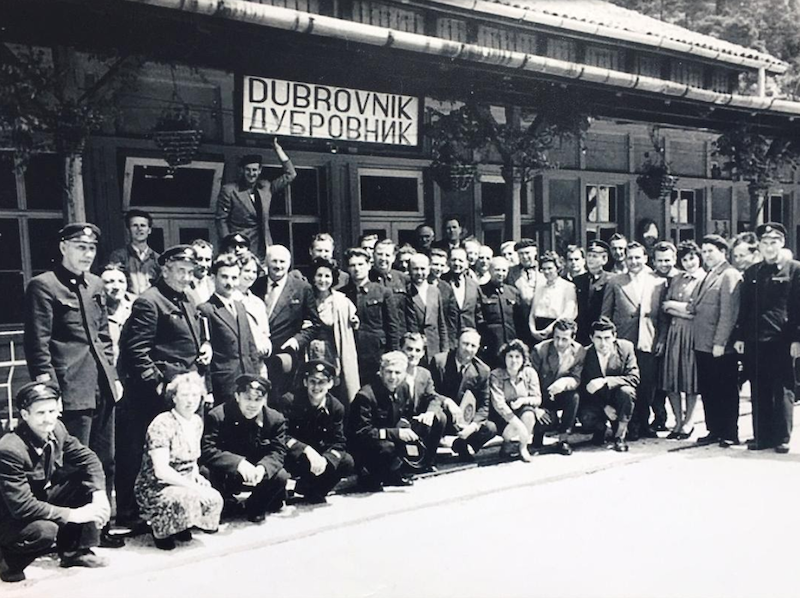
I had the joy of spending part of my career climbing mountains in North Wales, UK. One of my favourite places to climb was the rock slabs overlooking the old slate mining town of Blaenau Ffestiniog. This town used to be a hub of activity with the mined slate being transported from the mountains to the sea via a small narrow gauge steam train until imported slate killed the local industry and business eventually dried up. The train was no longer needed so stopped running and mass unemployment ensued as the area slumped into disrepair along with its inhabitants. In the 1990’s a passionate group of people came together and brought the 200-year-old railway back to life as a tourist attraction. Visitors flocked to the restored railway attraction seeking mountain scenery, coastline views and to relive a nostalgic journey back in history. The town of Blaenau Ffestiniog had new life breathed into it and flourishes to this day with the restored train line now being extended further on into the valleys of North Wales.
At present, partly due to Coronavirus and the lack of tourists in our area, unemployment is down by approximately 30% over last year so we look with positivity to the future of Čiro. Not only would the proposed project provide many new job opportunities but would benefit a large part of the local population with the possibility of kick-starting many affiliate businesses.
So is there light at the end of the tunnel amidst these troubling and doubtful times? We very much hope so and look to a much brighter year next with hopefully our first passengers arriving with a new zeal for the area and its opportunities; we’re not done yet, choo choo!
James Manning
Photos courtesy of Stanislav Vukorep
For the latest travel info, bookmark our main travel info article, which is updated daily.
Read the Croatian Travel Update in your language - now available in 24 languages
Tourism in the Corona Age: 10 Virtual Ways to Discover Cavtat and Konavle
June 21, 2020 - Tourism was on hold when we started this series of articles, but most of us have plenty of time. So let's look at the virtual resources available to explore Croatia virtually. We continue our new Virtual Croatia series with the tools to discover Cavtat and Konavle.
A few weeks ago I wrote that being a tourism blogger in the corona era was about as useful as being a cocktail barman in Saudi Arabia. I feel less useless now, a few weeks later, and I am encouraged by the number of Croatian tourism businesses who are contacting us wanting to start thinking of promoting post-corona tourism.
One of the challenges of writing about tourism at the moment is that there is nothing positive to write about. With people confined to their homes and tourism in Croatia currently not possible, many have decided to go into hibernation until it is all over.
I think that this is a mistake, and I have greatly enjoyed the TCN series by Zoran Pejovic of Paradox Hospitality on thinking ahead to tourism in a post-corona world. You can find Zoran's articles here.
Way back on March 14 - several lifetimes ago - I published an article called Tourism in the Corona Age: 10 Virtual Ways to Discover Zagreb. The way I saw things, now was an OUTSTANDING opportunity for tourism promotion. People have time, they yearn for their freedom and former lives, so give them the tools to thoroughly research and enjoy your destinations, and you will have then longing to be there. And when they do come, they will have a deeper understanding of the destination due to their research.
South Africa and Portugal were the first to do their post-corona tourism promotion videos several weeks ago (Post-Corona Tourism Planning: Lessons from South Africa and Portugal), a trick which has been followed by other tourism countries, the latest being Croatia with the national tourist board campaign, #CroatiaLongDistanceLove, going live yesterday.
But while these campaigns create longing and market presence, they don't really educate. People now have time to really get into destinations. And dreams of escape to somewhere more exotic are high on the list of priorities of many.
So TCN has decided to help with that education with a new series called Virtual Croatia, where we will be helping you discover many of Croatia's destinations with all the best virtual tools available on your self-isolating sofa at home.
We started with Tourism in the Corona Age: 10 Virtual Tools to Discover Hvar.
After this, we put our a press release (which you can read here in English and Croatian) offering a free article to any local tourist board in Croatia who would like the free promotion in our Virtual Croatia series.
The Sinj Tourist Board was the first to respond, and now you can see just how rich the tourism offer is in this proud Alka town - your virtual tools to Discover Sinj. This was followed by DIscover Opatija, Discover Brela, Discover Rogoznica, Discover Stari Grad, Discover Omis, Discover Lumbarda and Discover Jezera.
Today, Lucija Velizić from the Tourist Board of Konavle helps us tell you the story of the southernmost part of Croatia, of the tourism in Cavtat and Konavle.
Discover Cavtat and Konavle - the Gems in the South
Konavle is a region with particular natural beauties and contrasts: mountain and valley, green hills and naked stone, the blue, and the green. Cavtat is the biggest town in the Konavle region.
Official promotional video for Cavtat-Konavle region, made in 2019.
A somewhat older promotional video worth watching.
Žal beach in Cavtat
Get to know Cavtat old town and the beaches of Cavtat
When the guests really fall in love with a place, this is the kind of video they make.
Another lovely video made by a guest of Cavtat
Look Beyond Cavtat to the Konavle Region
Intro video for Konavle
Sokol-grad, magical fortress worth a visit
A perfect location for an active vacation
A pathway commemorating Ron Brown
Official Cavtat-Konavle Website
Find more materials about Cavtat and Konavle on the tourist board website, or find out more about Konavle or Cavtat.
Cavtat has been put on the list of the safest destinations to travel to post-corona.

Will you give Cavtat and Konavle a try this year or in the upcoming years?
To discover more of virtual Croatia, you can follow this series in our dedicated section, Virtual Croatia.
If you are a local tourist board in Croatia and would like your destination featured in this series for free, please contact us at This email address is being protected from spambots. You need JavaScript enabled to view it. Subject Virtual Croatia (and destination name)
Preparedness 2019: Earthquake Stimulation Exercise Held in Konavle
Following the recent and tragic earthquake which struck nearby Albania, and which was felt quite strongly across Dalmatia, from Dubrovnik all the way up to Zadar, an exercise called Preparedness 2019 was held in Croatia's southernmost municipality of Konavle, which lies just south of the City of Dubrovnik and right next to the Montenegrin border.
The fact that Preparedness 2019 was held precisely in Konavle is not only meaningful because of its geographical location, being in the extreme south of the country and close to tiny Montenegro which of course borders Albania, where the epicentre of the recent earthquake was located, but because Dubrovnik and its surrounding areas have always been vulnerable to earthquakes in the past.
A devastating earthquake struck Croatia's southernmost city way back in 1667, and the entire city was totally destroyed and around 5,000 residents tragically lost their lives.
As Morski writes on the 28th of November, 2019, the Civil Protection Headquarters of Dubrovnik-Neretva County held the staff-command exercise, called Preparedness 2019, in the gorgeous rolling hills of Konavle. The exercise was attended by the chiefs of civil defense staff of the City of Dubrovnik and the municipalities of Župa Dubrovačka (Parish of Dubrovnik) and of course the Konavle Municipality.
The topic of the Preparedness 2019 exercise was the engagement and coordination of civil protection operational forces in the event of an earthquake hitting Dubrovnik-Neretva County once again, and according to the played out scenario of this particular exercise, the wider Dubrovnik area would be affected, with the epicentre of the potential earthquake being in Konavle.
The objective of the exercise was to test the capabilities of the local civil protection operations forces should such an incident occur in the area, to see how their activation is, and to further enhance the forces' overall familiarisation with the planning documents in the field of civil protection.
Make sure to follow our dedicated lifestyle page for much more.


